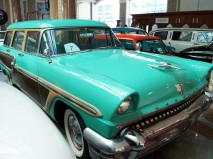1955 Mercury Monterey Station Wagon
top speed: 154 km/h (96 mph) (theoretical)
0- 60 mph 13.4 s; 0- 100 km/h 14.3 s (a-c simulation); 1/4 mile drag time (402 m) 19.3 s (a-c simulation)
fuel consumption and mileage: average estimated by a-c: 19.9 l/100km / 14.2 mpg (imp.) / 11.8 mpg (U.S.) / 5 km/l
Ford created its Mercury line-up in 1939 to fill the medium-priced gap between the Ford DeLuxe and its Lincoln-Zephyr models. The first Mercury was one of the first cars styled in Ford’s new in-house design studio and the first developed from a full-scale clay mock-up.
The Mercury proved to be a huge success and for 1955 there were more changes that would ensure its future. It was at this time Ford established Lincoln and Mercury as separate divisions in the Ford Motor Company. Completely redesigned for 1955, two Mercury series of cars began production, but a third was soon added. Within the Custom, Monterey and Montclair series was a complete line-up of models including convertibles and station wagons. As well as numerous engine options, air conditioning was offered as an option for the first time, but due to its bulkiness and complexity few were sold.
Although now separate divisions, Mercury models still incorporated many of the Lincoln styling cues and design features. Gone were the soft rounded edges of the previous models. Instead the bodylines were straight and added creases, hooded headlamps and the hint of a tail fin created a trimmer, more modern, jet-inspired appearance.
A fresher look was also created thanks to the “Dual-Beam” bumper grille combination, new vertical tail lamps and a new wrap-around windscreen, which also provided better vision. Inside, the 1955 Mercurys featured a new fan-shaped instrument panel and a unique design for the horn ring on the dished steering wheel. New colors and materials also brightened up the interior.
At the same time, prices were reduced in 1955 on many of the most popular options such as a radio, power steering and brakes. The same was true of such options as the Merc-O-Matic automatic transmission and Touch-O-Matic overdrive as well as many other convenience features. Whereas most Mercury models had a new 119-inch wheelbase, the station wagons stayed at 118 inches. In 1955 there were many small improvements made that resulted in a better-than-ever Mercury. Even the new V8 engine introduced in 1954 was improved upon with porting, a higher lift camshaft and a new “open wedge” cylinder head design. Road testers of the day praised the new Mercury models and noted better stopping ability, more hill climbing power, a better ride and improved front suspension, while still having the good handling characteristics of the Ford models.
5-door wagon body type
RWD (rear- wheel drive), automatic 3-speed gearbox
petrol (gasoline) engine with displacement: 4778 cm3 / 291.6 cui, advertised power: 138 kW / 185 hp / 188 PS ( SAE gross ), Torque net: 372 Nm / 274 lb-ft
characteristic dimensions: outside length: 5125 mm / 201.78 in, wheelbase: 2997 mm / 118 in
reference weights: shipping weight 1776 kg / 3915 lbs estimated curb weight: 1860 kg / 4100 lbs
how fast is this car ? top speed: 154 km/h (96 mph) (theoretical);
accelerations: 0- 60 mph 13.4 s; 0- 100 km/h 14.3 s (a-c simulation); 1/4 mile drag time (402 m) 19.3 s (a-c simulation)
fuel consumption and mileage: average estimated by a-c: 19.9 l/100km / 14.2 mpg (imp.) / 11.8 mpg (U.S.) / 5 km/l





